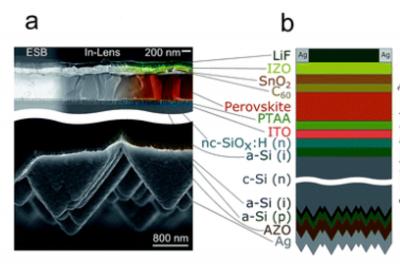Researchers from Helmholtz-Zentrum Berlin (HZB), Eindhoven University of Technology and Technical University Berlin have combined rear junction silicon heterojunction bottom cells with p'i'n perovskite top cells into highly efficient monolithic tandem solar cells with a power conversion efficiency (PCE) of 26.0%.
 Colored cross sectional SEM image of the top cell (upper panel) and back side of the bottom cell (lower panel) of a typical monolithic tandem solar cell used in this work. (b) schematic device layout of the tandem architecture utilized in this work.
Colored cross sectional SEM image of the top cell (upper panel) and back side of the bottom cell (lower panel) of a typical monolithic tandem solar cell used in this work. (b) schematic device layout of the tandem architecture utilized in this work.
Starting from a certified efficiency of 25.0%, further improvements have been reached by reducing the current mismatch of the certified device. The top contact and perovskite thickness optimization allowed increasing the JSC above 19.5 mA cm'2, enabling a remarkable tandem PCE of 26.0%, however with a slightly limited fill factor (FF).
This finding was confirmed by electrical simulations based on input parameters from reference single junction devices. The simulations reveal that especially the FF in the experiment is below the expected value and show that with improved design it should be possible to reach 29% PCE for the monolithic perovskite/silicon tandem device and 31% PCE if record perovskite and silicon cell single junctions could be combined in tandem solar cells.
This work provides a detailed device understanding under different current matching conditions, which would be vital on the path to improve the PCE potential of silicon/perovskite tandem solar cells to predicted values above 30%.

